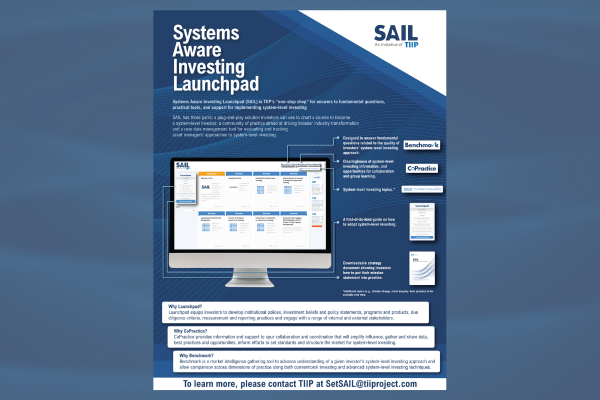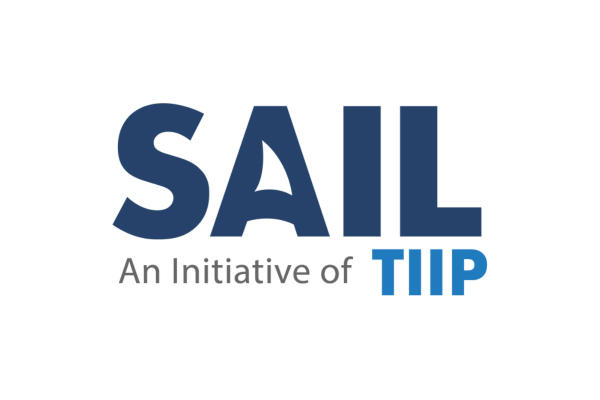System-level Investing in Practice: New Case Studies Released
New York, September 23, 2025 – The Investment Integration Project (TIIP) today released a series of five case studies that illustrate how institutional investors are embedding system-level investing strategies into their work to address the specific systemic risk of climate change. The case studies, commissioned by the High Meadows Institute for the Sustainability in Capital Markets project, examine the practices of foundations, pension funds, asset managers, and investment consultants that are aligning long-term value creation with the health of environmental systems.
These case studies add to a growing body of evidence that system-level investing is not theoretical—it is happening in practice across the market. Together with our recent 10-Year Review of the Rockefeller Brothers Fund, which documented a decade of outperformance achieved through mission-aligned investing with a systems lens, this new series shows that investors can protect portfolios, meet fiduciary obligations, and drive resilience.”
– William Burckart, CEO @ TIIP

Since 2016, the High Meadows Institute has tracked progress on the market integration of ESG and sustainable finance in its flagship Sustainability in Capital Markets reports. In its 2025 report, HMI turned its focus to the climate crisis, exploring how key sectors in the financial system are engaging with the transition to a sustainable low-carbon economy (SLCE). The analysis, divided into individual sector snapshots, assesses the current roles of asset owners, asset managers, market intermediaries and other players in accelerating the transition, evaluating their level of commitment, as well as reflecting on the drivers and challenges to increasing support.
The in-depth case studies TIIP developed in support of this project identify and analyze the practices of leading firms who are pioneering the use of system-level investing to address systemic issues like climate change, including:

PGGM, managing €227 billion for Dutch healthcare workers, has built its strategy around the principle that long-term returns depend on sustainable systems. From divesting oil and gas companies without Paris-aligned transition plans to creating the SDI Taxonomy for impact measurement, PGGM uses its scale and universal ownership model to accelerate the energy transition.
Download the case study here.

The McKnight Foundation has embedded climate and equity across its $2.6 billion endowment, committing to net-zero emissions by 2050 and channeling over $500 million into impact investments that decarbonize the economy and build resilient communities. Its investment policy explicitly seeks to shift market norms by signaling to managers and peers the seriousness of the energy transition.
Download the case study here.

Cambridge Associates, advising over $560 billion, was the first U.S. investment advisor to sign the Net Zero Investment Consultants Initiative. The firm blends research, client education, and manager due diligence to embed climate as a systemic risk, while its Social & Environmental Equity (SEE) Framework adds a distinctive equity lens to net-zero strategies.
Download the case study here.

Wespath Benefits and Investments, one of the world’s largest faith-based pension funds, integrates its Sustainable Economy Framework into a $24 billion portfolio—balancing fiduciary duty with system-level influence. Through initiatives like the BlackRock Transition Ready Portfolios, it has cut portfolio carbon intensity by 50% while expanding exposure to climate technologies.
Download the case study here.

Domini Impact Investments is a women-led impact investment manager with $2.1 billion AUM, pioneering a system-level focus on forests and land use as critical levers for climate stability and human rights. By developing forest-specific investment beliefs and effectiveness principles, Domini drives engagement on deforestation, regenerative agriculture, and Indigenous rights.
Download the case study here.
Across both the review of the Rockefeller Brothers Fund, and these new case studies, the message is clear: fiduciary duty today requires a system-level lens. Whether managing a pension fund, stewarding a foundation’s endowment, advising clients, or constructing portfolios, investors are recognizing that the health of their portfolios is inextricably tied to the health of the systems they inhabit.”
– Monique Aiken, Managing Director @ TIIP
This latest series of case studies extends nearly a decade of TIIP’s work to build the evidence base for system-level investing. 
From the landmark “Tipping Points 2016” report that first mapped how investors were innovating to address systemic issues, to analyses of Central Banks and Development Finance Institutions, to the “Approaching the Tipping Point” industry needs assessment in 2022, and the 2024 case studies of “Investors Leading the Way,” TIIP has consistently provided practical proof points and frameworks for the field.
The RBF report, “Returns, Risk, and Responsibility”, released in August 2025, demonstrated how one institution translated its divestment decision into a comprehensive strategy that produced a 7.76 percent annualized return over ten years—outperforming its benchmark with 27 percent less risk—while advancing climate, equity, and governance outcomes.
Read the RBF 10-Year Review here.
 Today, that evidence base is further reinforced by the Benchmark component of TIIP’s SAIL platform, which now includes detailed profiles of more than 160 institutional investors, enabling comparative analysis of system-level practices across asset owners, managers, and consultants.
Today, that evidence base is further reinforced by the Benchmark component of TIIP’s SAIL platform, which now includes detailed profiles of more than 160 institutional investors, enabling comparative analysis of system-level practices across asset owners, managers, and consultants.
Together, these publications, tools, and platforms underscore TIIP’s role in making system-level investing both actionable and measurable for the investment community.
To learn more about the SAIL platform, schedule a demo or subscribe, email us at [email protected].
About The Investment Integration Project (TIIP)
The Investment Integration Project (TIIP) is a boutique consulting firm that helps institutional investors: 1) understand how portfolio performance is intertwined with the health of environmental, social, and financial systems; 2) shape the structures and norms influencing those systems; and 3) embed systems-aware decision-making across all strategies and operations.
Established in 2015 by Steve Lydenberg and William Burckart—who coined the term system-level investing—TIIP’s pioneering thought leadership has enabled the alignment of investment practices with the long-term health of the systems underpinning value creation. At the center of TIIP’s work is SAIL (Systems Aware Investing Launchpad), an enterprise management and data platform that enables investors to integrate system-level investing across strategy, implementation, and governance.
TIIP also offers customized services—Total Portfolio Activation, Total Portfolio Implementation, and Total Portfolio Review—to help clients benchmark progress, enhance portfolio design and stewardship, and apply system-level thinking in practice.
For more information, visit https://www.tiiproject.com.










